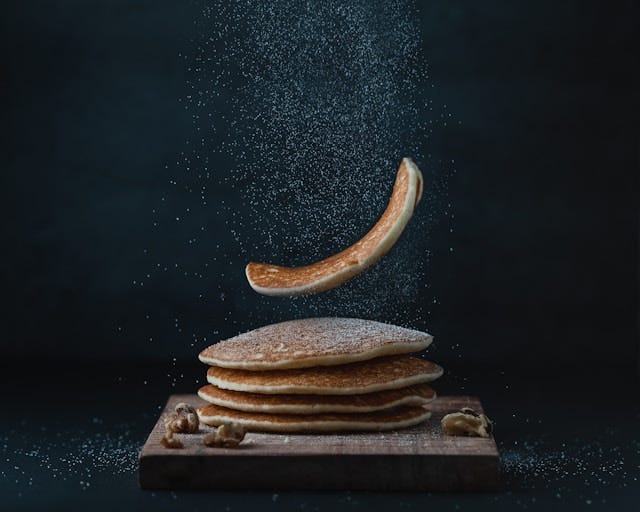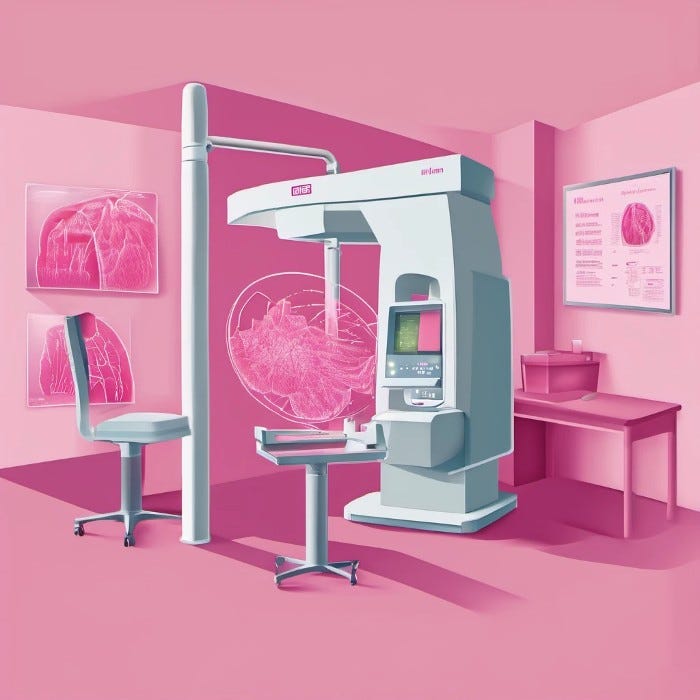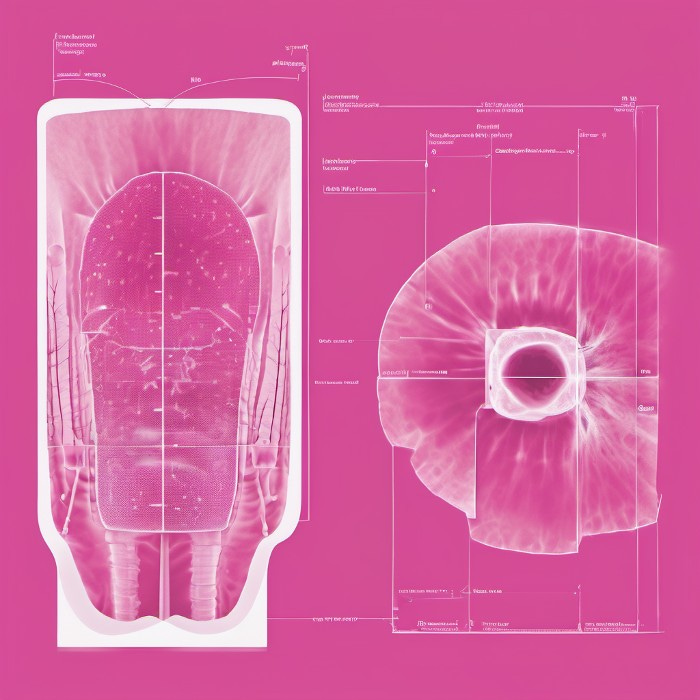Mammograms, pancakes, talk shows and tech: My first breast cancer exam
BlackTechLogy: Could artificial intelligence better examine black women with dense breasts?

This post is part of a series entitled “BlackTechLogy.” Click here for the archived posts.
There have been moments in my teenage years when I’m fully convinced my mother (a retired credit union manager) missed her calling to be the next Jordan Peele. But instead of making creepy movies like “Candyman,” “Us,” “Nope” or “Get Out,” she could just visit random teen girl groups and give them colorful health advice.
For example, her take on a pap smear and a speculum was so wild that I decided I was going to be an agnostic* nun. The entire gynecology exam sounded like way too much trouble to have sex.
And because I’m a glutton for punishment, I asked her what a mammogram was like. She stood in front of me, stretched her arms out and slapped her hands.
“They do this to your boobs,” she said, and she started rubbing her hands together like a spatula flattening a pancake. I was horrified.
When my primary care physician told me that mammogram recommendations were now encouraged for women in their 40s instead of their 50s, my response was, “That’s nice. Not doing it.”
Jordan “Vaughn” was on my mind. But she wasn’t the only one.
ADVERTISEMENT ~ Amazon
As an Amazon Affiliate, I earn a percentage from purchases using my referral links.
There was another memory I had of someone else’s mammogram. My mother loved “Windy City Live” and would watch it often. She thought co-host Val Warner looked like a Barbie doll and would tell me that on occasion. She was so into the show that she got me into watching it. One episode, among many, is forever in my memory bank. Val Warner got a mammogram and voluntarily allowed the results to be read during the show.
I’m sure she expected the results to say she was A-OK. Instead, the radiology report resulted in the radiologist telling her she needed to have a follow-up exam. I watched that bright, beautiful smile of hers slowly lower. Ever the professional, she continued on with the rest of the show and even fought back tears when her co-host (Ryan Chiaverini) comforted her. I cringed, but what happened to her was educational for me. It was the first time I’d ever heard about black women having “dense” breasts.
Luckily, she turned out to be OK and her follow-up results were fine.
(Writer’s note: I cannot find that first video. During the first mammogram, the show ended with her not knowing her results, and she told the audience about her follow-up several days later. I believe the video linked above is a second mammogram six years later.)
ADVERTISEMENT ~ Amazon
As an Amazon affiliate, I earn a percentage from purchases with my referral links. I know some consumers are choosing to boycott Amazon for its DEI removal. However, after thinking about this thoroughly, I choose to continue promoting intriguing products from small businesses, women-owned businesses and (specifically) Black-owned businesses who still feature their items on Amazon. All five of my Substack publications now include a MINIMUM of one product sold by a Black-owned business. (I have visited the seller’s official site, not just the Amazon Black-owned logo, to verify this.) If you still choose to boycott, I 100% respect that decision.

Between watching Val’s experience and hearing about my mother’s, after I turned 40, I just wasn’t into the idea of pancake breasts or news that could change my life. I waited until I was 41 to see what it was all about. Interestingly, I went into a fit of giggles watching the two plates apply pressure for the X-ray machine. Although mildly uncomfortable when the mammogram is sideways instead of frontward facing, the tech assured me that the technology has improved significantly over the years. But your breasts really do look like pancakes in those plates.
Then the mammogram complications happened
When I got my test results and was told one breast was too dense to give me accurate results, I didn’t even panic. Why? Because that “Windy City Live” episode involuntarily prepared me for the risks that black women may face. I was ready for this to be the response without any proof of whether my own breasts were dense or not.
On the financial side of health care
I went through a considerable amount of back-and-forth with my health insurance company post-mammogram. Although they covered an annual screening, follow-up exams were a mixed bag. Depending on what was written on the radiology report, the follow-up visit could be considered like a specific doctor’s visit or be treated like a wellness exam. (One is free. The other is not.)
To make matters even more complicated, although I visited an in-network hospital and there were in-network doctors at the facility, the initial radiology report was examined by a radiologist who worked in Illinois but had an office in another state. And the bill came through as “out of network” because his out-of-state address was on it. And asking the hospital to resubmit the radiology report with his in-network address fell on deaf ears. I was so frustrated by the experience that I canceled my follow-up appointment to resolve the initial expenses first. While I should’ve been focused on breast health, the health care industry (per usual) took me on financial roller coaster ride.
For women with no insurance, there are programs such as the Illinois Breast and Cervical Cancer Program (IBCCP). For women with insurance — and I wish I knew this before the in-state/out-of-state confusion — a free-standing clinic may cost less than a hospital-affiliated facility. According to my health insurance provider, it may also be less likely that there are a swarm of doctors affiliated with a smaller clinic so it’s easier for nurses to narrow down who is in-network and out-of-network.
Recommended Read: “Why are you rating black churches on Yelp? ~ Should churches receive travel reviews?”
On the tech side of health care
This year though, I’ve been observing how artificial intelligence (AI) can influence mammogram results. According to the New York Times, with a trial involving 80,000 women, “the software picked up six cases of cancer in every 1,000 women, while radiologists found five per 1,000 women.”
Additionally, the Food and Drug Administration is allowing patients in a small number of clinics and hospitals to perform an AI mammogram. However, there is currently no billing code that radiologists can use to charge insurance providers for the technology. And to no one’s surprise, that means some centers may charge the customer instead — between $40 to $100 out of pocket for an AI analysis. That doesn’t mean all clinics or hospitals will do it, but anyone who has ever dealt with the “in-network” debate knows it’s pretty reasonable to believe the cost will come from the patient’s purse.
While I have always had a hate-to-love attitude with AI, I’m leaning away from this idea for now. Even if it’s cheaper, there’s something about having another woman in the room to pay attention when there is discomfort during the mammogram or cheer you along.
I remember what it was like to have to take multiple MRIs after twisting my ankle in too-cute shoes. My first tech played jazz music, spoke softly and I felt like I was in a snug lounge. The second tech just ordered me to be still and talked to fellow co-workers while I was in the machine. I was just ready to get out of there.
With a mammogram, my tech was as nice as the first MRI guy. Health care workers may not realize how much that is appreciated. For a first-time mammogram, I’d suggest women do it the old-fashioned way — with a human. Once they’re used to getting mammograms annually, then maybe AI is the way to go. With the way technology is changing (and sometimes replacing humans), women may not have much of a choice in the matter. For now though, just have your pancake flattening by someone with a heartbeat.
* During my mammogram appointment, the nurses were oddly persistent about knowing my religion. In four decades, no one has ever stopped me pre-visit to clarify via text, print and before I walked into the exam room about my affiliation with religion. What does that have to do with breast health? For that alone, I should’ve turned on my heels and left. I’ll never go back to that hospital again nor do I recommend it.
Did you enjoy this post? You’re also welcome to check out my Substack columns “Black Girl In a Doggone World,” “BlackTechLogy,” “Homegrown Tales,” “I Do See Color,” “One Black Woman’s Vote” and “Window Shopping” too. Subscribe to this newsletter for the weekly posts every Wednesday. Thanks for reading!







